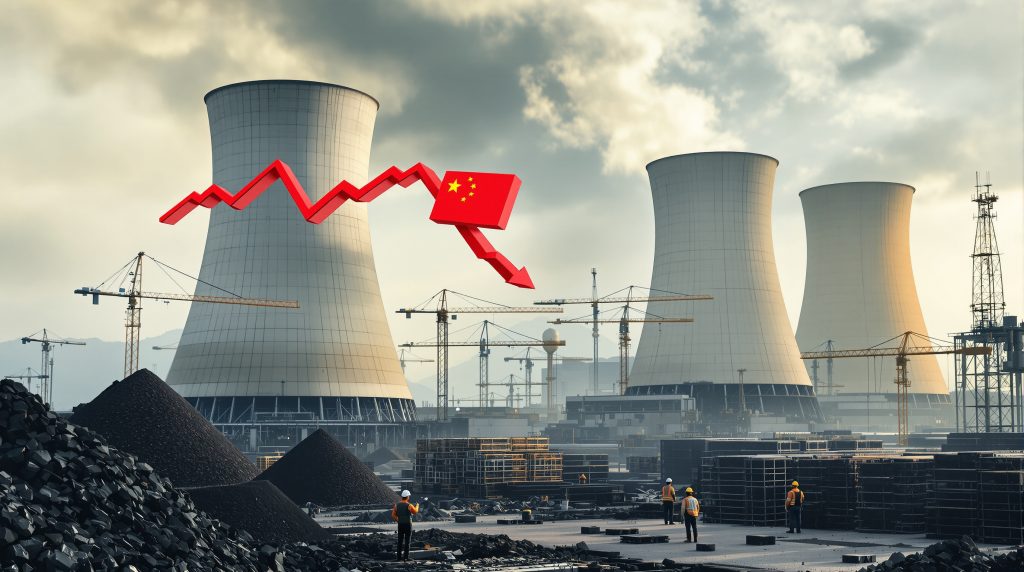China's Steel Industry Under Pressure: Demand Slowdown Signals Structural Shift
China's steel sector faces significant challenges as demand shows clear signs of softening despite the traditional construction season. Recent market data reveals the ratio between steel rebar futures and iron ore prices has fallen to its lowest level since 2020, indicating severely compressed profit margins for steel producers. This market imbalance highlights the structural challenges facing China's steel industry amid broader economic transitions and the China and steel demand slowdown.
Key Market Indicators Showing Pressure
The steel rebar to iron ore price ratio reached its lowest point since 2020 according to Bloomberg data, serving as a widely watched gauge of the steel market's health. This ratio decline clearly signals narrowing margins for producers across the industry.
Mill profitability has been fluctuating at historically low levels, with analysts expecting this trend to continue. As Han Jing from SDIC Futures Co. noted, "The mills' profitability is now expected to fluctuate at a lower level," highlighting the ongoing challenges producers face.
Despite weak steel demand, iron ore prices have shown remarkable resilience, with Singapore iron ore futures reaching levels not seen since February 2025. This price divergence further exacerbates the profit squeeze for steel manufacturers.
Shanghai rebar contracts declined for four consecutive days as of September 11, 2025, heading toward the lowest levels since July, reflecting persistent demand weakness.
Why is Chinese Steel Demand Declining?
Property Market Crisis and Construction Slowdown
The prolonged downturn in China's real estate sector continues to be the primary driver behind weakening steel demand. With property development historically consuming approximately 55% of China's steel output, the sector's ongoing struggles have created a significant demand gap that other industries cannot fill.
The ratio weakness underscores how China's steel sector remains inextricably tied to its struggling property market and slowing construction activity, both major consumers of reinforcement bar (rebar). Though steel mill margins performed better than expected earlier in 2025 as cheaper raw materials helped push down costs, this advantage appears to be diminishing.
Real Estate Market Challenges
Property developers face continued liquidity constraints despite government efforts to stabilize the sector. New construction starts have declined significantly year-over-year, with real estate investment continuing its multi-year downtrend.
Unsold commercial housing inventory remains at concerning levels, creating a substantial oversupply situation that will take years to resolve even with favorable policy interventions.
Construction activity continues its multi-year downtrend, with little evidence of a meaningful recovery on the horizon despite seasonal patterns that typically boost steel consumption.
Government Policy Constraints
Beijing's strategic policies aimed at controlling production and emissions have added another layer of complexity to the steel market dynamics.
The government has maintained a zero growth mandate for steel output since 2021, limiting producers' ability to increase volumes even when demand conditions might otherwise support expansion.
Carbon emission reduction targets continue affecting production capacity, as steel manufacturers must balance output with increasingly stringent environmental compliance requirements.
Sector restructuring plans announced in early 2025 signal further consolidation ahead, potentially reducing fragmentation but also creating uncertainty for smaller producers.
Production discipline measures to address overcapacity remain in effect, constraining supply even as demand weakens.
Economic Rebalancing Effects
China's ongoing transition from an infrastructure-focused growth model to a more consumer-oriented economy has fundamentally altered the demand landscape for steel.
The shift away from steel-intensive infrastructure investments toward service sector expansion has reduced the steel intensity of economic growth. Even robust GDP numbers no longer translate to proportional increases in steel consumption.
Manufacturing growth has proven insufficient to offset the construction decline, despite efforts to stimulate industrial production through various policy measures.
Changing consumption patterns are reducing per-capita steel intensity as the economy matures, following patterns observed in other developed economies.
Service sector expansion is replacing traditional industrial growth, further diminishing steel's role in the broader economic picture.
What's Happening with Iron Ore Prices Despite Weak Steel Demand?
Supply Concerns Driving Price Increases
Despite softening steel demand, iron ore trends have shown remarkable resilience, creating a paradoxical market situation that further squeezes steel producers.
Dalian iron ore futures reached the highest levels since July 2025 due to supply worries from the Simandou mine in Guinea and the upcoming restocking season in China, which boosted market sentiment. These factors have supported prices despite weakening fundamentals in the steel sector.
Factors Supporting Iron Ore Prices
Simandou mine supply uncertainties in Guinea have created concerns about future iron ore availability. Despite being one of the world's largest untapped high-grade iron ore deposits, ongoing development challenges continue to delay consistent production.
Seasonal restocking demand in China traditionally supports iron ore prices during certain periods, regardless of immediate steel production needs.
Mills have limited ability to push down raw material costs, as noted by Han Jing from SDIC Futures Co.: "It's difficult for mills to push down the raw material prices."
Singapore iron ore futures have reached levels not seen since February 2025, highlighting the divergence between raw material costs and finished steel prices.
The Profitability Squeeze for Steel Mills
The divergence between raw material costs and finished steel prices has created a challenging operating environment for Chinese steel producers.
As Foshan Financial Holdings Futures Co Ltd. explained in an analyst note, "Weak demand for finished steel products has kept steel prices subdued, yet the incentive for mills to sustain production is strong with modest profit margins. Iron ore prices are projected to outperform finished steel products."
Mill Response Strategies
Despite narrowing margins, many producers maintain production levels, prioritizing market share and operational continuity over short-term profitability.
The limited ability to pass on higher input costs to end-users reflects weak demand fundamentals and intense competition among producers.
Mills are increasingly focused on production efficiency improvements to reduce costs wherever possible, including energy consumption optimization and labor productivity enhancements.
Export increases help offset domestic demand weakness, though this strategy faces growing resistance from international markets concerned about iron ore surplus outlook.
How Are Global Markets Responding to China's Steel Slowdown?
Export Surge as Domestic Outlet
Chinese steel producers have significantly increased exports to compensate for weakening domestic demand, creating ripple effects throughout global markets.
Export volumes have reached multi-year highs as producers seek alternative markets for their output, putting pressure on producers in other regions who must compete with Chinese prices.
Domestic consumption decline has been partially offset by this export growth, though the strategy faces growing headwinds from international trade tensions.
Global steel price dynamics have been significantly influenced by Chinese export volumes, with many markets experiencing downward pressure as a result.
International trade tensions continue rising due to increased Chinese steel exports, with several countries considering or implementing new trade defense measures.
Raw Material Market Impacts
The slowdown in Chinese steel demand has created significant downstream effects for raw material suppliers globally.
Impact on Key Commodities
Iron ore prices have displayed notable volatility despite overall demand concerns, creating challenges for miners and traders in managing price risk.
Coking coal markets face pressure due to reduced steel production expectations, with prices fluctuating based on short-term production adjustments.
Scrap steel import patterns have evolved as mills adjust input mixes to optimize costs and quality, creating new opportunities for some suppliers while challenging others.
Alloying elements show variable demand patterns based on shifts in steel product mix, with some specialty materials performing better than bulk commodities.
What Does the Future Hold for China's Steel Industry?
Long-Term Structural Decline Projections
Industry analysts project that China's steel demand has entered a long-term structural decline phase that will reshape global markets.
Consumption is expected to decrease gradually but persistently over the coming decade, with annual declines becoming the new normal rather than temporary cyclical downturns.
China's share of global steel demand is projected to fall significantly by mid-century as other developing regions increase their consumption and China's own needs moderate.
Peak steel consumption of nearly 1 billion tons likely occurred in the past, with future trajectories pointing consistently downward despite occasional short-term rebounds.
Gradual capacity rationalization seems inevitable as demand continues to soften, though the pace will likely be managed carefully to avoid economic and social disruption.
Growth Shifting to Other Regions
As China's steel consumption moderates, other developing regions are expected to drive future growth in global steel demand.
Emerging Steel Demand Centers
India stands out as the most significant growth market, with its ambitious infrastructure development plans, expanding manufacturing base, and urbanization trends supporting increasing steel intensity.
Southeast Asian nations are accelerating infrastructure development, creating substantial demand growth potential as their economies expand and urbanize.
Middle East and North Africa regions are expanding industrial capacity, diversifying economies, and investing in construction, all supporting increased steel consumption.
Developed economies show potential for renewed demand through reindustrialization efforts, particularly related to energy transition and manufacturing reshoring initiatives.
Environmental Policy Influences
China's environmental policies will continue to shape the future of its steel industry, potentially accelerating the transition toward lower production volumes.
Carbon neutrality targets are driving production constraints as the industry must find ways to reduce emissions while maintaining economic viability.
The shift toward electric arc furnace production using scrap represents a fundamental transformation of the production landscape, reducing reliance on iron ore and coal.
Higher-quality, lower-volume steel production focus aligns with both environmental goals and the changing needs of China's more sophisticated manufacturing sectors.
Green steel initiatives are changing production economics, with premium products commanding better margins despite higher production costs.
How Might China's Steel Slowdown Impact Global Commodity Markets?
Iron Ore Producers Facing Challenges
Major iron ore suppliers face significant uncertainty as their largest customer experiences structural demand changes.
Potential oversupply scenarios loom as Chinese demand moderates, though timing and severity remain subjects of debate among industry analysts.
Price volatility is expected to continue despite long-term concerns, with market participants adapting to more frequent and pronounced price swings.
Quality premiums will likely increase as mills focus on efficiency and environmental compliance, benefiting producers of higher-grade ore.
Diversification strategies from major producers aim to reduce China exposure, with investments in processing, finished products, and alternative markets becoming more common, including BHP's strategic pivot.
Opportunities in Specialty Steel Markets
Despite overall demand challenges, certain specialty steel segments may offer growth potential even within a declining market.
High-value specialty steel for advanced manufacturing applications continues showing resilience, with demand supported by China's industrial upgrading initiatives.
Materials for renewable energy infrastructure benefit from China's energy transition policies, creating demand even as traditional construction steel consumption declines.
Automotive-grade steel for electric vehicle production represents a growth segment, though total volume remains modest compared to construction applications.
Construction steel for earthquake-resistant buildings and other specialty applications maintains demand due to safety regulations and quality requirements, despite broader construction weakness.
What Are the Key Indicators to Watch?
Critical Metrics for Market Observers
Investors and industry participants should monitor several key indicators to gauge the trajectory of China's steel market.
Steel mill capacity utilization rates provide early signals of production adjustments, with sustained declines indicating recognition of structural demand weakness.
Property market investment trends remain critical given the sector's outsized influence on steel consumption, with particular attention to new starts and completion rates.
Infrastructure spending announcements can indicate potential demand support from government stimulus efforts, though the steel intensity of such projects has generally declined.
Steel export volumes and pricing reveal how producers are responding to domestic demand challenges and provide insight into global market impacts.
Raw material inventory levels at ports signal restocking patterns and producer sentiment about near-term production plans.
Mill profitability ratios, particularly the relationship between rebar and iron ore prices, provide insight into the health of the steel production sector.
Government policy announcements on production caps, environmental regulations, and industry restructuring offer valuable forward-looking information about the operating environment.
China's Steel Market: Key Questions Answered
What is causing the decline in Chinese steel demand?
The primary factors driving China's steel demand decline include the prolonged property market downturn, government-mandated production restrictions, and the country's economic transition away from infrastructure-led growth toward a more consumption-based model.
The real estate sector's struggles represent the most significant immediate factor, with declining construction activity directly impacting rebar and other construction steel products.
How are steel mills responding to the profit squeeze?
Mills are maintaining production despite narrow margins, seeking efficiency improvements to reduce costs wherever possible.
Export increases help offset domestic demand weakness, though this strategy faces growing resistance internationally.
Product mix adjustments toward higher-value offerings allow some producers to maintain profitability despite volume challenges.
Consolidation through mergers and acquisitions is accelerating as weaker producers struggle to maintain viability in the challenging market environment.
Will iron ore prices collapse due to China's steel slowdown?
While long-term concerns exist about iron ore demand, prices have shown remarkable resilience due to several factors.
Supply uncertainties, including development challenges at major projects like Simandou in Guinea, continue supporting prices despite demand concerns.
Seasonal restocking patterns in China create periodic price support regardless of immediate steel production needs.
Mills face difficulty pushing down raw material prices despite their own margin pressures, as noted by industry analysts.
The potential for production discipline from major iron ore producers could prevent price collapse even as demand moderates.
Which countries might benefit from China's declining steel consumption?
India stands out as the most promising growth market for steel, with its infrastructure development plans and urbanization trends supporting increased consumption.
Southeast Asian nations accelerating infrastructure development represent important growth markets as their economies expand.
Middle Eastern countries with growing construction sectors and industrial development plans show potential for increased steel consumption.
Developed economies pursuing reindustrialization and energy transition projects may increase steel consumption after years of stagnation.
How might China's steel slowdown affect global decarbonization efforts?
China's production constraints could accelerate the transition toward greener steelmaking technologies as producers seek efficiency improvements and environmental compliance.
Investment in hydrogen-based direct reduction methods may increase as traditional blast furnace economics become more challenging.
Electric arc furnace production using scrap will likely grow in importance, reducing the carbon intensity of China's steel sector.
Green premium products may gain market share faster than previously expected as producers seek higher-margin opportunities in a challenging market.
Navigating the New Normal in Chinese Steel Markets
China's steel industry faces a pivotal transition as demand softens amid structural economic changes. The traditional model of ever-increasing steel consumption appears to have reached its limits, creating challenges for both domestic producers and global suppliers of steelmaking raw materials.
For industry participants, adapting to this new reality requires strategic flexibility, cost discipline, and potentially a fundamental rethinking of business models built around assumptions of continuous Chinese demand growth. The coming years will likely bring significant restructuring within China's steel sector as it aligns with the country's evolving economic priorities and environmental commitments.
While challenges abound, opportunities exist for those who can navigate this transition effectively—particularly in higher-value steel products, alternative markets, and more sustainable production methods. The era of China-driven steel demand growth may be ending, but the industry's evolution continues as global production centers shift and technological advancement reshapes production methods.
Understanding China's steel market transition remains essential for commodity investors, producers, and consumers worldwide, as the ripple effects will continue influencing miner demand insights from iron ore mining in Australia to steel fabrication in emerging economies and construction projects globally.
Ready to Capitalise on the Next Major Mineral Discovery?
Discovery Alert's proprietary Discovery IQ model provides instant notifications for significant ASX mineral discoveries, delivering timely, actionable insights that help investors stay ahead of market movements. Explore how major mineral discoveries have historically generated substantial returns by visiting the Discovery Alert discoveries page and position yourself for potential market-beating opportunities.




